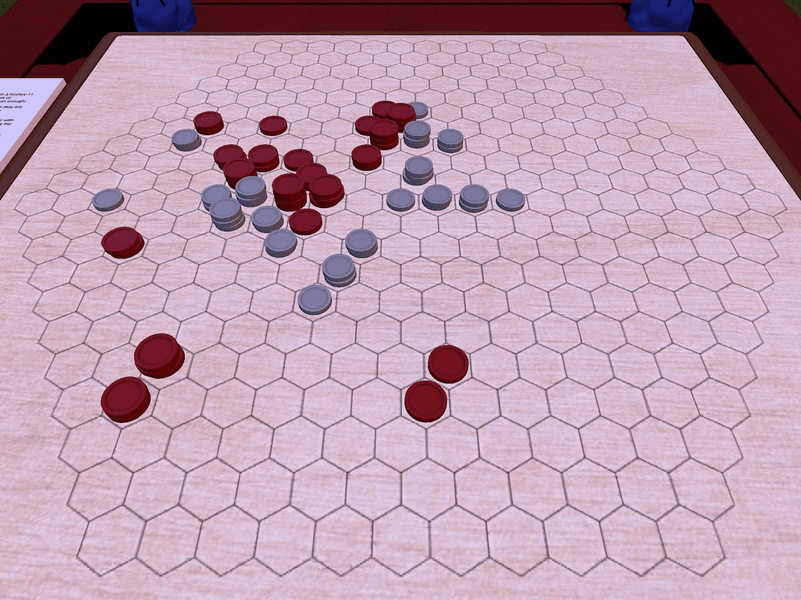Regular readers will know when it comes to a preferred style of game I lean heavily toward abstract strategy games; Hive, Arimaa, checkers and chess among them.
So when a new game comes along in the genre I tend to be drawn to them with some interest.
So it was with Tumbleweed the latest creation by Michal Zapala.
Hailing from Poland, Tumbleweed evolved in many ways out of a life-long love of board games.
“Some of my first memories involve playing Ludo, Draughts and Snakes & Ladders with my mom: I think I might have learned to play before I’ve learned to read,” Zapala said via email. “And, very early on I’ve decided I want to make games of my own.
As a kid I made a lot of generic roll-and-move race games, then as a teen I started experimenting with Go variants, (one of the ancient classics), and chess variants.
“Few of those attempts were even playable, and none was particularly interesting.”
But as the old saying goes, ‘if at first you don’t succeed ... ‘ and so it was for Zapala.
“My adventure with designing games has only truly begun at the start of this pandemic,” said the 23-year-old. “Being temporarily out of university and not having much else to do, I got fixated on boardgames to the point where they almost became a full-time activity. I started experimenting with more original ideas, and I discovered the very helpful BGG (Board Game Geek) Abstract sub-forum: soon, results followed.”
A quartet of games have been created, but Tumbleweed appears to hold the creator’s interest most.
“Overall, Tumbleweed is my fourth, and so far final, game that I’m really satisfied with.” he offered. “... I think I’m really satisfied with my current oeuvre. If Tumbleweed was the last game I ever made, I would have no regrets!
Tumbleweed is a two-player game. It is played on a hexhex board and a sufficient supply of stacked checkers. Hexhex-8 is the most common board size, although hexhex-11 is recommended for high-level play.
But, Zapala was not deterred.
“At the time, I was learning to play Amazons, and I was stunned by its architecture. The game is ostensibly a stalemate game, not unlike Draughts: but anyone who played a game or two will tell you it’s actually territorial,” he said. “Territory is never defined in the rule set, yet it emerges very sneakily as you play.
“I wanted to try the same trick: convert the vulgar, explicit ‘control’ of Tore into something more subtle and emergent. The best way of doing it was with threat of capture. One very long stream of consciousness later, a promising prototype came
A stack is said to be “seen” from a hex, when they are connected by a straight line, with no stacks in between.
The players take turns “settling” hexes by placing a stack of their tokens on a hex of their choice. The stack height is equal to the number of your stacks in sight of the settled hex. Only hexes that see at least one of your stacks may be settled.
Removing a stack occupying a hex and re-settling it with a new stack is possible, as long as the new stack is taller than the previous one. This works with opponent stacks (to capture), or your own stacks (to reinforce).
So, what was the idea which led to the game’s creation?
“Before Tumbleweed, I came up with a combinatorial game named Tore,” explained Zapala. “The goal was to control empty hexes, based on lines of sight: if a hex cell could see more of your own pieces than those of your opponent, you controlled it. Placement was only legal on hexes controlled by neither player.
“Unfortunately, the game had serious flaws: it ended very quickly, and it was almost impossible to determine legal moves -- let alone perform any meaningful analysis -- without a self-scoring interactive board.”
to be. Playing it reminded me of the way tumbleweeds spread with the wind, hence the name.
“I was also inspired by fellow inventors of the BGG Abstract sub-forum: most notably Dale Walton, who proposed many territorial games based on lines of sight, and Alek Erickson, who’s Benediction made me fall in love with the idea of stacks.”
Ultimately Tumbleweeds came into existence as a way to save the work put into Tore from С����Ƶ a waste.
“I wanted it to improve upon Tore, and I had much fun toying with many cool concepts I’ve never successfully used before; hex boards, lines-of-sight, stacks, in such a simple, cohesive package,” offered Zapala.
“But beyond that, I don’t recall having any particular ambitions about it. I only started to take it more seriously after play testing it with Alek, a skilled designer in his own right: we’ve became good friends and we play test each other’s games very often, but it was the first time I saw him this excited!
“That С����Ƶ said, I had many boardgame-related dreams I wanted to eventually fulfill: a game of mine С����Ƶ available for synchronic online play, a community forming around one of my designs -- Tumbleweed gave me all that and many more.”
Interestingly the game developed rather quickly.
“Tumbleweed has a very cohesive rule set: once I came up with the basic idea, very few decisions were left to be made: stuff like board size, balancing protocol and so on,” said Zapala.




